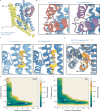Structural basis of the obligatory exchange mode of human neutral amino acid transporter ASCT2
- PMID: 39095408
- PMCID: PMC11297037
- DOI: 10.1038/s41467-024-50888-8
Structural basis of the obligatory exchange mode of human neutral amino acid transporter ASCT2
Abstract
ASCT2 is an obligate exchanger of neutral amino acids, contributing to cellular amino acid homeostasis. ASCT2 belongs to the same family (SLC1) as Excitatory Amino Acid Transporters (EAATs) that concentrate glutamate in the cytosol. The mechanism that makes ASCT2 an exchanger rather than a concentrator remains enigmatic. Here, we employ cryo-electron microscopy and molecular dynamics simulations to elucidate the structural basis of the exchange mechanism of ASCT2. We establish that ASCT2 binds three Na+ ions per transported substrate and visits a state that likely acts as checkpoint in preventing Na+ ion leakage, both features shared with EAATs. However, in contrast to EAATs, ASCT2 retains one Na+ ion even under Na+-depleted conditions. We demonstrate that ASCT2 cannot undergo the structural transition in TM7 that is essential for the concentrative transport cycle of EAATs. This structural rigidity and the high-affinity Na+ binding site effectively confine ASCT2 to an exchange mode.
© 2024. The Author(s).
Conflict of interest statement
The authors declare no competing interests.
Figures






References
-
- Chen, M. et al. Loss of RACK1 promotes glutamine addiction via activating AKT/mTOR/ASCT2 axis to facilitate tumor growth in gastric cancer. Cell Oncol. 10.1007/s13402-023-00854-1 (2023). - PubMed
MeSH terms
Substances
LinkOut - more resources
Full Text Sources
Molecular Biology Databases

